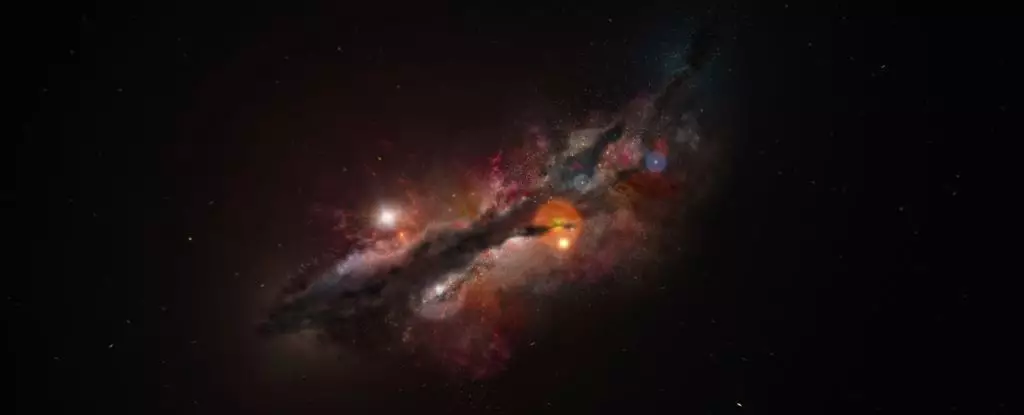The recent discovery of the galaxy JADES-GS-z14-0 has sent shockwaves through the astronomical community, transforming our understanding of the infancy of the cosmos. Emerging just 300 million years after the Big Bang, this galaxy boasts an unexpectedly high concentration of oxygen—an element long thought to be absent in such early structures. The revelation challenges long-held assumptions about the timeline of cosmic evolution and suggests that the early universe was far more complex than previously believed. This newly observed galaxy does more than just intrigue scientists; it provides critical insights into the formation of galaxies and the elemental richness of the universe at a remarkably early stage.
The Class of Cosmic Giants
In the realm of astronomy, finding a galaxy like JADES-GS-z14-0 poses serious questions for existing cosmological models. Traditionally, it has been postulated that galaxies require significant time to accumulate mass and energy, forming through successive generations of stars and supernovae—the process by which heavier elements, including oxygen, arise. However, the properties of JADES-GS-z14-0 signal a premature maturity; as cosmologist Sander Schouws aptly notes, it’s akin to finding an adolescent in a playground of babies. The rich elemental composition detected in this galaxy suggests not only rapid formation but also a sophisticated developmental trajectory that challenges the linear narrative of cosmic history.
The journey of elements in the universe began with the Big Bang, where only hydrogen and helium were formed. It was through the gravitational collapse of these gases that the first stars ignited; only through their lifecycle, culminating in spectacular supernovae, could oxygen and other heavier elements be forged. Given the galaxy’s age and its plentiful oxygen, one must grapple with the implications: what accelerated this process? Why would such a galaxy exist so soon after the universe’s inception?
Questioning Established Norms
The discovery of JADES-GS-z14-0 forces us to reevaluate our understanding of galactic evolution speeds. The study, which harnessed the capabilities of the Atacama Large Millimeter/submillimeter Array in Chile, found that the amount of heavier elements was startlingly higher—by an astonishing factor of ten—than models had anticipated. Astrophysicist Stefano Carniani’s astonishment at these values highlights a seismic shift in cosmic narratives. The implications are profound: if galaxies could indeed grow and mature within mere hundreds of millions of years post-Big Bang, it demands a radical restructuring of the cosmological timeline.
The findings underscore the ever-evolving nature of scientific understanding. The early Universe, previously depicted as a barren expanse dominated by hydrogen and helium, may have been a bustling arena of star formation and chemical enrichment. Thus, we must confront questions about the mechanisms driving this rapid cosmological evolution. What unique conditions in the universe facilitated this accelerated growth, and how did it influence subsequent cosmic structures?
Implications for Future Research
As astronomers continue to utilize the power of telescopes such as the James Webb Space Telescope, more insights into the early stages of galaxy formation will likely emerge. The detection of JADES-GS-z14-0 is not merely an anomaly; it is a hint of a broader trend that suggests a thriving cosmological environment earlier than we had presumed. If the findings regarding high oxygen levels are corroborated by subsequent studies, this could redefine our approach toward understanding the history of elemental development within the universe.
Furthermore, this discovery invokes the necessity to reassess existing models of galaxy formation. The findings imply that current frameworks, which rely on a slower timeline of star and galaxy maturation, may be significantly flawed. Researchers will need to scrutinize the assumptions that have long governed our understanding of the cosmos. This scrutiny is crucial, as cosmologists aim to create models that reflect not only the observed universe but also the unknown, mysterious processes that may yet be at play.
The New Narrative of Cosmic Development
In addition to the technical challenges that these findings present, they evoke a sense of wonder about our universe’s narrative. The story of galactic formation is no longer a slow and deliberate march toward complexity; it may instead be a dynamic and vibrant dance of rapid growth and evolution. Future investigations into JADES-GS-z14-0, along with other similar discoveries, may help illuminate how galaxies interact and evolve in ways previously unimagined.
With the current research laid out in papers accepted by esteemed journals, this discussion has only begun. JADES-GS-z14-0 is not merely a find; it is a cosmic enigma that demands answers and inspires awe among those who dare to look through the lens of our finest telescopes. The rapid growth of such galaxies raises the stakes in our pursuit of knowledge, urging humanity to uncover the convolution that shaped our universe’s early landscape. The early Universe may be far more astonishing than we could have ever anticipated.


Leave a Reply